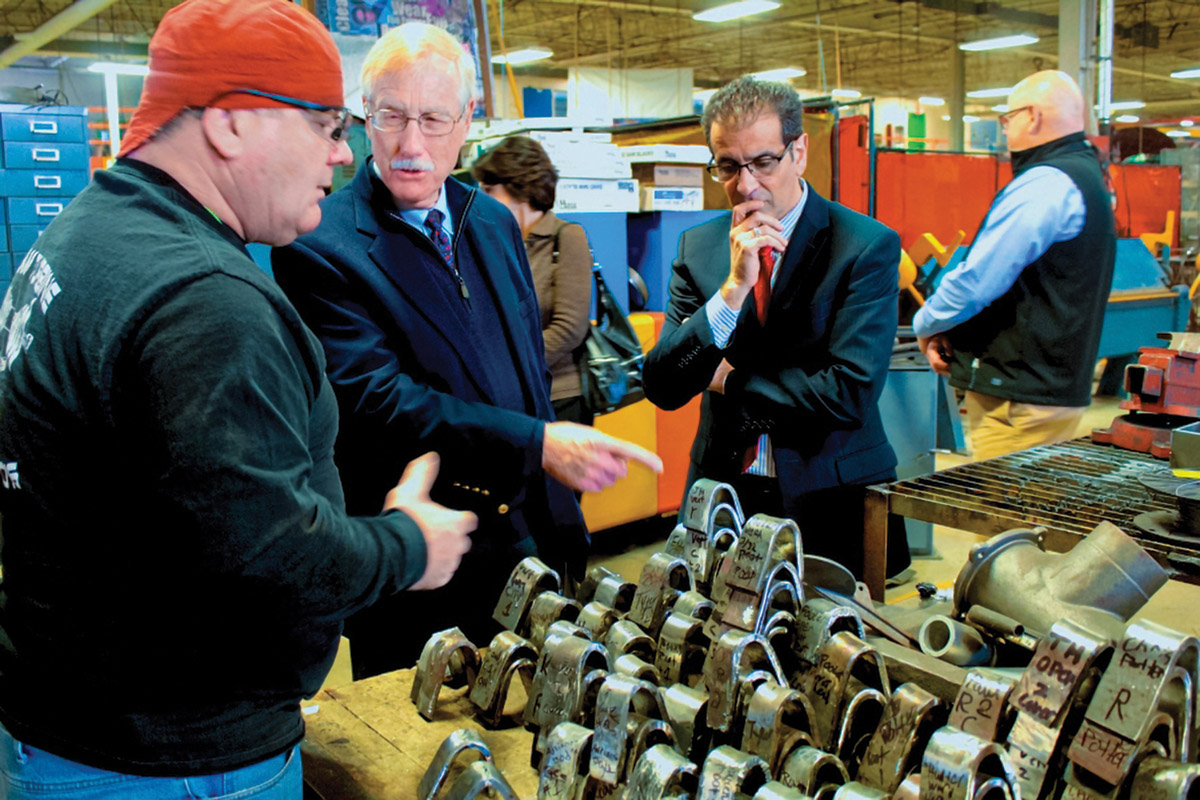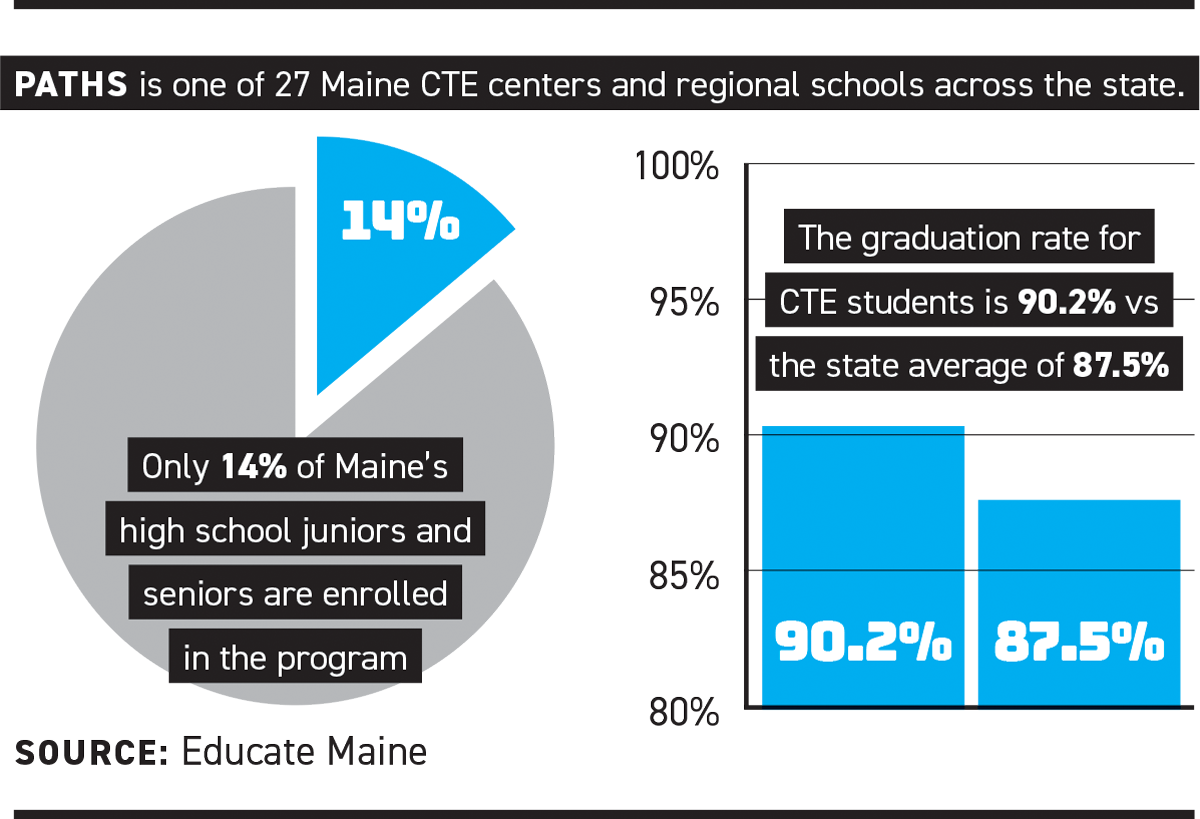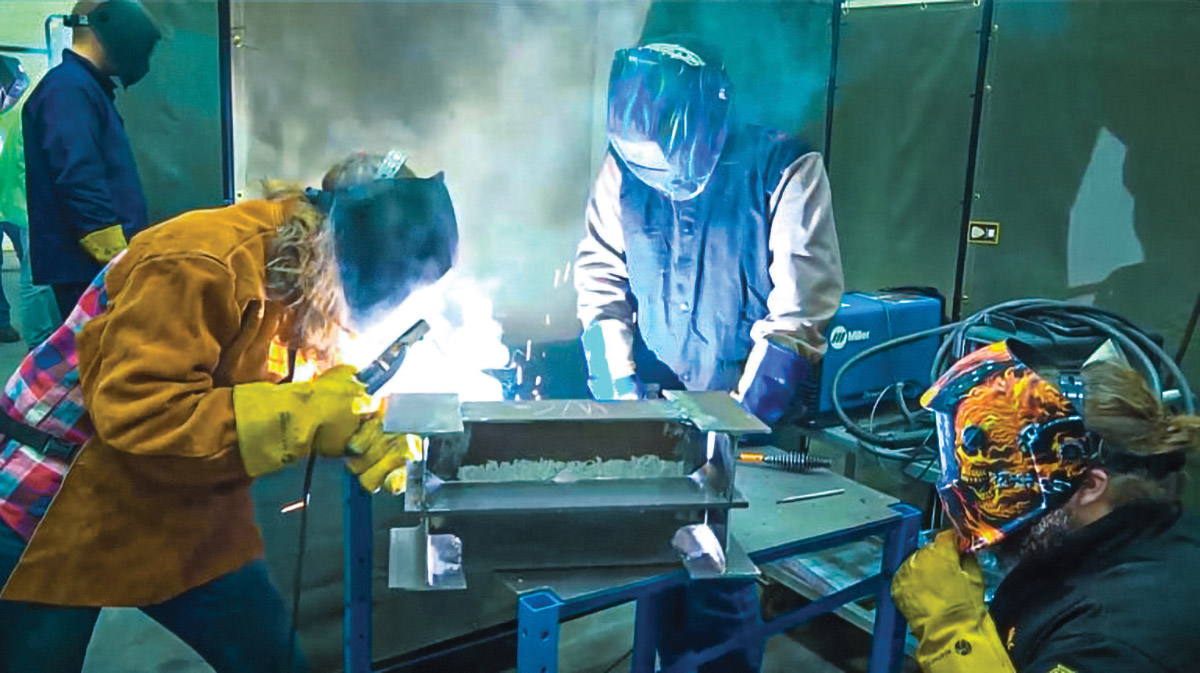
U.S. Sen. Angus King says of Portland Arts & Technology High School, “This kind of education is more important than ever … because of the interconnection with the economy.”
Prepping students for a career
Students who attend the Portland Arts and Technical High School graduate with certified skills from any of 19 programs, ranging from nursing assistant training to masonry to business marketing.
This coming year, they can also specialize in cyber security.
Those students who will go on to college are a step ahead of many of their classmates. Those entering the job market are also ahead of the pack.
Every year, anywhere from 475 to 525 juniors and seniors from 18 southern Maine high school attend PATHS programs, part of the 8,500 or so of the state’s high school juniors and seniors enrolled in the state’s Career and Technical Education program.
Kevin Stilphen, director of PATHS, would like to see more.
“We’re providing opportunities for students,” Stilphen says.
Opportunities that include decent-paying jobs after graduation, or a head start on post-secondary education, apprenticeships, and more.
PATHS is one of 27 Maine CTE centers and regional schools across the state. While some of Maine’s 182,500 high school students take a course here or there, only 14% of juniors and seniors are enrolled in the program. Students in CTE programs are still required to take standard high school courses, like English, math, social students and science.
“I know more students could benefit,” Stilphen says.
Taking part in a Maine Career Technical Education program “doesn’t limit opportunities, it expands them,” Stilphen says. “We’ve seen amazing successes.”
He’s not alone. The state Department of Education set a goal in 2015 to double CTE enrollment by 2020. Educate Maine released a report in 2016 that set out strategies, including increasing career pathways from 10 to 16, updating public perception, expanding private business partnerships, making partnerships more feasible for small businesses, reinforcing partnerships with Maine colleges, removing regulatory and policy barriers to enrolling in CTE programs, and expanding pre-apprenticeship offerings.

Business, college connections
“It’s a great time to be in CTE,” Stilphen says. He means that for both students and those who run the programs.
The input from businesses is “amazing,” he says. The centers all have connections to businesses that help students get hands-on training — programs like the summer apprenticeship program with Cianbro, Maine’s largest construction company.
They continually look at how to make the program better and how to strengthen partnerships to meet the state’s economic needs.
The connection with Maine’s Community College System allows students to continue a career path. Students can also enter the Bridge program junior year, in which they can earn 26 or more college credits without college costs.
Three-quarters of CTE programs offer students the chance to earn college credits. More than 42% of CTE students enroll in a two- or four-year college right after graduation.
According to Educate Maine, the high school graduation rate for students concentrating in CTE programs was 90.2%, the state average overall was 87.5%.
The program also has technology update groups in every industry it represents — from agriculture and auto body to composites manufacturing and emergency medical services. They make sure curriculum is up to date and students meet standards

SMCC welding lab used for job training in partnership with Bath Iron Works
Undercurrent of entrepreneurship
What programs are offered is also continuously reviewed.
That’s why PATHS is adding cyber security. Before programs are added, Stilphen says, adminstrators study market research, national standards reviews, state and national trends and more.
The Capital Area Technical Center in Augusta this year is joining five other CTE schools that offer Fire Science.
The program description on Westbrook CTE’s website makes it clear it’s about more than fighting fires. Students will also be expected to develop oral and written communication skills, computer skills, science, math, physical fitness, observation, attention to detail, investigation and radio communication etiquette.
Once students complete the program, they’ll have entry level job opportunities as E-911 dispatchers and firefighters. If they go on to a post-secondary fire science program, they can become fire investigators, forest rangers or insurance investigators.
Stilphen says that there are other programs that may seem old-fashioned or obsolete that need students and offer high-paying and quality employment.
“The skilled trades are the fabric of our world, and people should take great pride in doing that work”
— Dan Coffey, Cianbro Institute
Masonry is one example.
“That’s a trade that’s not going away, it doesn’t lend itself to automation,” he says. Besides the fact there is a shortage of masons and there’s a lot of work to be had, it also takes skill and artistry, and offers opportunities students may not consider.
Another one is marine systems — repairing boat engines and other marine-related work.
“Our programs have a strong undercurrent of entrepreneurship,” he says. “It’s in-demand work. It’s not necessarily easy work, but there are a lot of opportunities.”
We don’t offer dead ends
One thing that keeps enrollment down is logistics. Students in CTE programs are juniors and seniors and must fit it into their regular high school curriculum, traveling to the CTE center for the program’s classes. Maine doesn’t have the resources or population to offer CTE programs in every high school, according to the department of education. Another issue is the perception of what CTE is.
“Change the perception of the skilled trades,” Dan Coffey of the Cianbro Institute says in the Educate Maine report. “There is a tendency to push all kids to a college education no matter what. There’s a negative perception of construction workers, people who work with their hands. The impact that these people have on our lives is enormous. Go through your daily routine: structurally sound warm home, hot water, TV, cooking, driving. For all that you need a carpenter, boilermaker, electrician, plumber, mechanic. The skilled trades are the fabric of our world, and people should take great pride in doing that work.”
The college connection is also solid, the report points out.
Peter Hallen, director of Mid Maine Technical Center in Brunswick, says that a professor in the University of Maine Electrical Engineering Department told him that they prefer students with CTE experience in high school.
“Students with strictly academic courses aren’t as well prepared as electrical students from the CTE, because they’ve had no exposure to the technical or applied aspects of the field,” Hallet says.
Stilphen says the education also empowers students. The structure of the program works no matter what post-high school plans a student has.
“No longer is it either/or,” Stilphen says. “No longer is it a binary choice of a vocational education or a college path. It doesn’t lessen the value of their high school education, it increases it. We don’t offer programs that lead to career or educational dead ends.”
A ‘courageous choice’
Another benefit of the program is that it’s an avenue for students who may not adhere well to the typical academic path. Students in the program are doing something they’re interested in, and want to be there, Stilphen says.
He sees students all the time who’ve “made the courageous choice to step outside the comfortable path — a student’s getting on the bus early in the morning to come here from Buxton for a welding program,” while her classmates are going to classes at their high school.
He says that’s “the most important thing.”
“A lot of them get a concept of what they want to do,” he says. “They’re experiencing success, they’re doing something they enjoy. Choice plays a huge role — it gives the students some say.”
The program pays for students’ certification exams at the end of programs, and other costs associated with programs.
“All it costs the student is stepping outside of their comfort zone and committing to it,” he says. ◾
Career and technical education sites
The Maine Career Clusters framework comprises 10 career clusters and related career pathways to help students explore career options and better prepare for college and a career. They are an organizing tool for the state, communities, centers and regions to develop more effective programs. The following 10 career clusters offered at Career and Technical Education schools and the related career pathways listed below them form the structure for the dozens of courses offered at Maine’s CTE schools.
AGRICULTURE & NATURAL RESOURCES
Wood Harvesting
Architecture, Construction & Manufacturing
Building Trades
Drafting
Electrical
Machine Tool
Small Engine Repair (includes Marine Maintenance)
Welding
ARTS, AUDIO/VIDEO TECHNOLOGY & COMMUNICATIONS
Graphic Arts
Multimedia
BUSINESS MANAGEMENT, ADMINISTRATION, FINANCE, MARKETING, SALES & SERVICE
Business Studies
Cooperative Education
Marketing/Sales
CTE EMPLOYABILITY SKILLS
CTE Employability Skills
EDUCATION & PUBLIC SERVICE
Early Childhood Education
HEALTH & HUMAN SERVICES
Health Services
HOSPITALITY & TOURISM
Cosmetology
Culinary Arts
Travel and Tourism Management
PUBLIC SAFETY & SECURITY
Public Safety
SCIENCE, TECHNOLOGY, ENGINEERING AND MATHEMATICS & INFORMATION TECHNOLOGY
Computer Repair/Install
Composites Manufacturing
Pre-Engineering Technology
TRANSPORTATION
Automotive Technology
Auto Body
Heavy Equipment and Commercial Driving
MAINE’S CTE CAREER AND TECHNICAL CENTERS AND REGIONAL SCHOOLS
Maine CTE centers are governed, operated and administered by a single school administrative unit; a CTE region comprises all the school administrative units within a geographical boundary. There are 27 CTE centers and regional schools in Maine.
CENTERS
Bath Regional Career and Technical Center / 207.443.8257
Biddeford Regional Center of Technology / 207.282.1501
Augusta / Capital Area Technical Center / 207.626.2475
Caribou Technology Center / 207.493.4270
Machias / Coastal Washington County Institute of Technology / 207.255.0345
Farmington / Foster Technology Center / 207.778.3562
Ellsworth / Hancock County Technical Center / 207.667.9729
Naples / Lake Region Vocational Center / 207.693.3864
Lewiston Regional Technical Center / 207.795.4144
Waterville / Mid-Maine Technical Center / 207.873.0102
Portland Arts & Technology High School / 207.874.8165
Presque Isle Regional Career and Technical Center / 207.764.1356
Calais / St. Croix Regional Technical Center / 207.454.2581
Frenchville / St. John Valley Technology Center / 207.543.6606
Sanford Regional Technical Center / 207.324.2942
Skowhegan / Somerset Career and Technical Center / 207.474.2151
Dexter / Tri-County Technical Center / 207.924.7670
Van Buren MSAD 24 / 207.868.2746
Westbrook Regional Vocational Center / 207.854.0820
REGIONAL SCHOOLS
Region 2 — Southern Aroostook County, Houlton / 207.532.9541
Region 3 — Northern Penobscot Technical Center, Lincoln / 207.794.3004
Region 4 — United Technologies Center, Bangor / 207.942.5296
Region 7 — Waldo County Technical Center, Waldo / 207.342.5231
Region 8 — Mid-Coast School of Technology, Rockland / 207.594.2161
Region 9 — School of Applied Technology, Mexico / 207.364.3765
Region 10 — Technical High School, Brunswick / 207.729.6622
Region 11 — Oxford Hills Technical High School, Norway / 207.743.7756
SOURCE: www.maine.gov/doe


